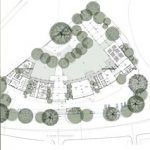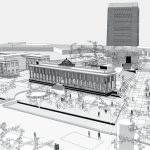Client: Vidyalankara Pirivena Vidyalankara Pirivena | Ministry of Urban Development & Sacred Area Development | National Physical Planning Department | Cultural Affairs
Sri Lanka like many countries is in a static state of rapid development. Within the last three decades mainly due to the war and the intense stress that the public were in a framework of thinking have impeded the potential for the country to prosper into new avenues using the experience and knowledge from the rich past that is truly unique to Sri Lanka.
Rarely is it seen where ideas are built upon philosophy, as in most western countries and are mainly channeled through the religions. With a religious base that from the past have influenced all components of the country, we have the opportunity to use this as a medium in which a new catalyst could be introduced in order to make the public, rethink with originality, and deeper philosophical bases.
The selected site is instrumental in establishing religio-cultural factor [e.g Shanthi Nekethan] that is not only limited to Buddhism but a famous philosophy and cultural regeneration. The institute will be of a Buddhist base but an open building to all cultures of the society. The site is home to the Vidyalankara Pirivena, Kelaniya established in 1875 and houses many Buddhist religious buildings within the premises.
The term: ‘impermanence’ expresses the Buddhist notion that all of conditioned existence, without exception, is in a constant state of flux. The Pali word ‘anicca’ literally means “inconstant”, and arises from a synthesis of two separate words, ‘nicca’ and the “privative particle” ‘a’, where the word ‘nicca’ refers to the concept of continuity and permanence, ‘anicca’ refers to its exact opposite; the absence of permanence and continuity.
CONCEPT
In Buddhism emptiness is a characteristic phenomena arising from the fact, that nothing possesses essential, enduring identity due to the impermanent nature of form. In the Buddha’s spiritual teaching, insight into the emptiness of phenomena (Pali: suññatanupassana) is an aspect of the cultivation of insight that leads to wisdom and inner peace.
This impermanence with respect to time creates an atmosphere which is beyond the physical [metaphysical] and the atmosphere, thus created is the main idea of the architectural concept in creating a “Relative Behavior” that is Human – Human, Building[form-space] and Building [form]– Building[space]
All things and events, whether ‘material’, mental or even abstract concepts like time, are devoid of objective, independent existence. Therefore the architectural spaces created are generated with the notion of triggering the relative behaviour that makes the human users ‘ think’, ‘interact’, ‘experience’ and ‘explore’.
Diverging from the traditional and contemporary used spatial progression with is linear. The architecture is targeted to create an explorative progression with, ‘consciousness’ syntax being created along paths selected. Idea of the ‘Maluwa’ [platform] being repeated being experimented, and fluctuating effects being added to contextual responses and this repetition being carried through to undulating level in the latter stages of the design.
The concept of impermanence leading to the relative behavior alongside, traditional Pirivena architecture that distributes in the 2D place with ‘Maluwas’ [platform] as key interaction areas, are reinterpreted in 3D place, giving it an extra dimensional extension, that catalyse the Behavioral Relativity as well as inspiration from advanced Sri Lankan graphic art that have ceased to develop to the next level for centuries.

















